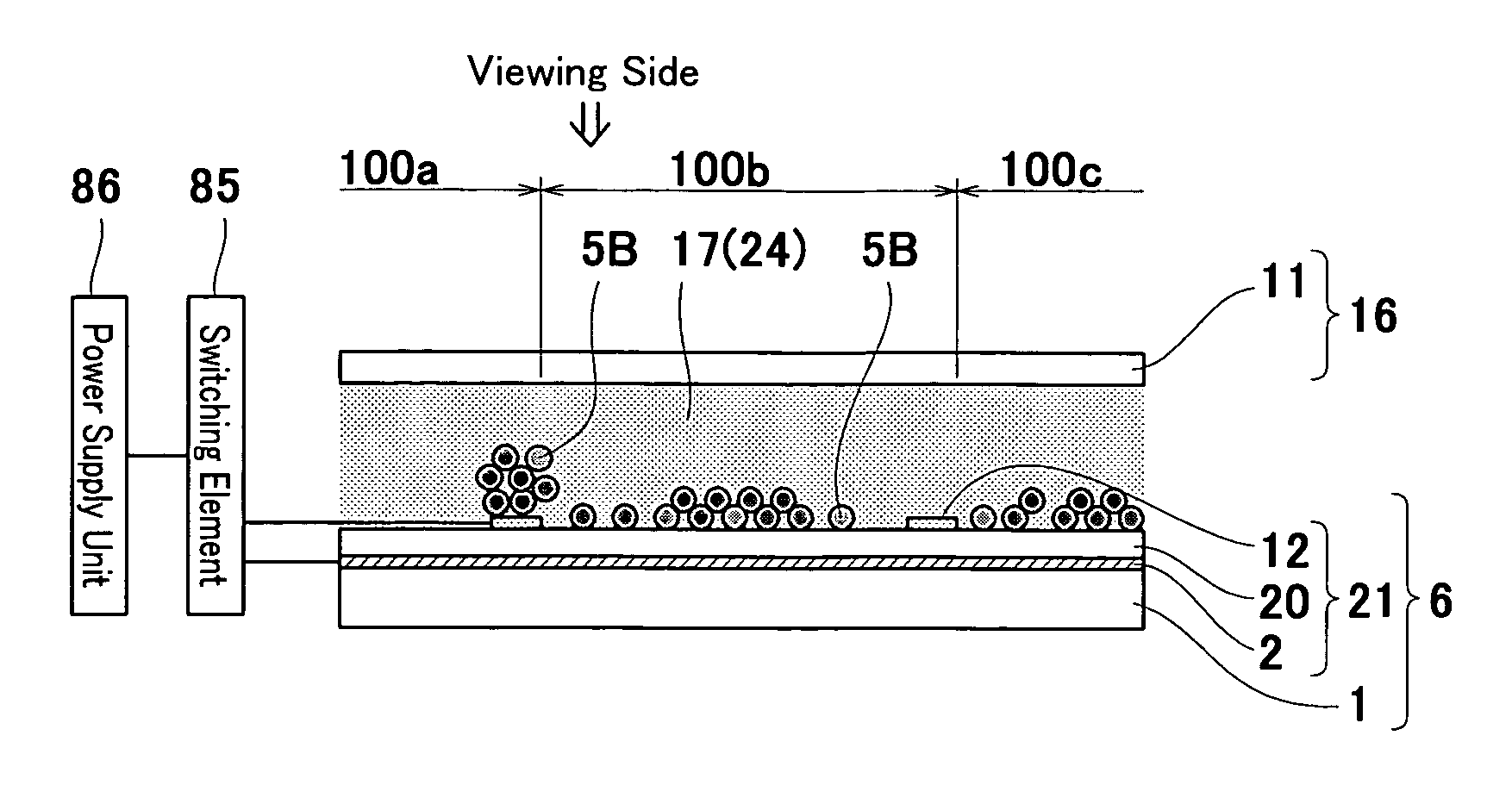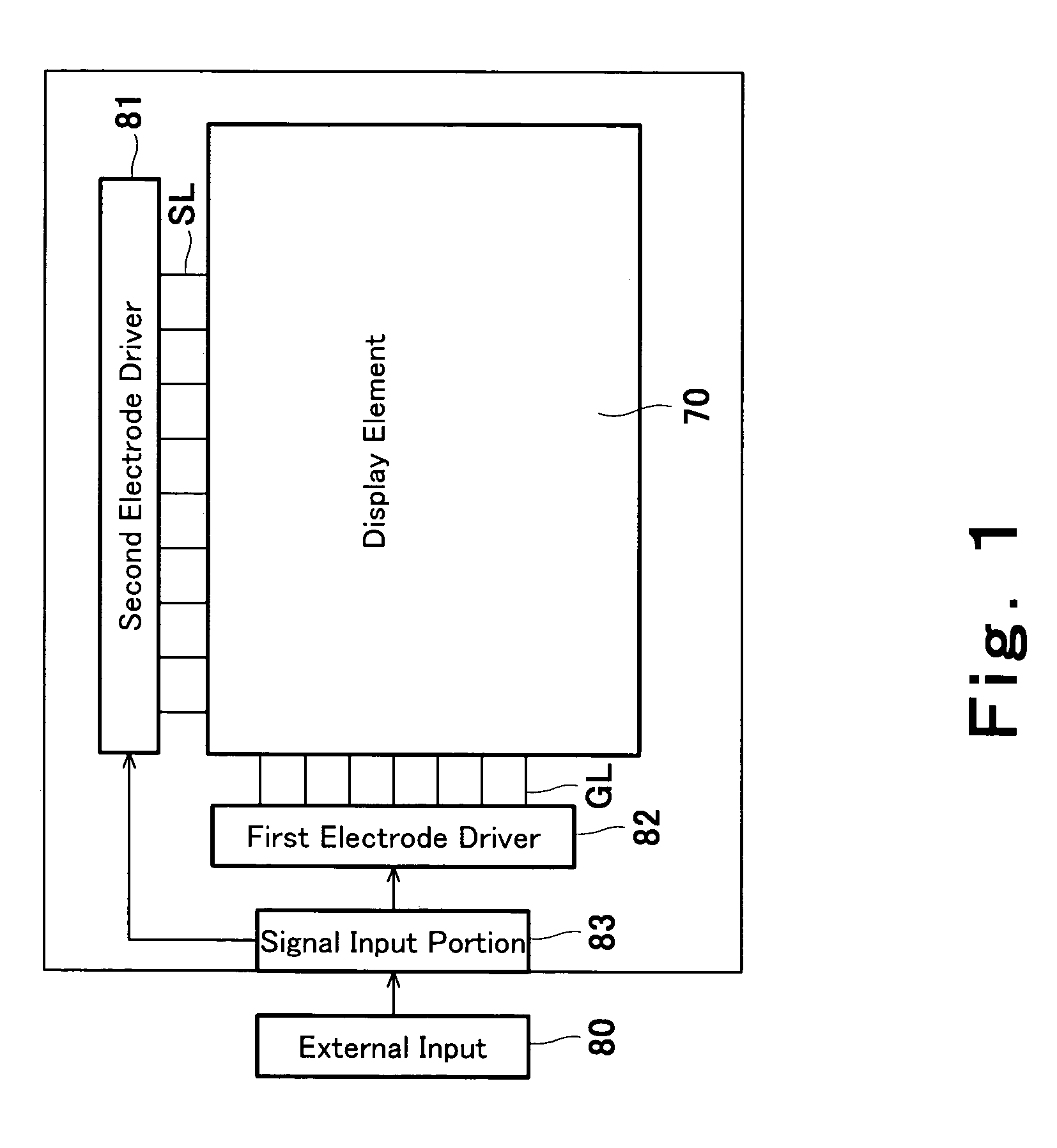Display device and method of manufacturing same
- Summary
- Abstract
- Description
- Claims
- Application Information
AI Technical Summary
Benefits of technology
Problems solved by technology
Method used
Image
Examples
first preferred embodiment
[0102]FIG. 1 is a schematic view showing a display device according to a first preferred embodiment of the present invention. FIGS. 2A to 2C are schematic views showing the configuration of a pixel that constitutes a display element of the display device shown in FIG. 1, which show its cross sections perpendicular to the display screen (hereafter, referred to as “vertical cross sections”).
[0103]As shown in FIGS. 1 and 2A to 2C, the display portion of the display device is composed of a display element 70, which is a display panel. The display element 70 has, as shown in FIGS. 2A to 2C, a lower substrate 6 and an upper substrate 16, and the substrates 6 and 16 are opposed to each other by being supported by a spacer 3′ to have a desired gap distance. Thereby, a space 17 is formed between the substrates 6 and 16. The space 17 is partitioned by the spacer 3′, and thus, the spacer 3′ is referred to as a partition wall 3 herein. Each individual region of the space 17 partitioned by the p...
example
[0138]This Example specifically discusses a method of manufacturing a display element according to the present embodiment. Herein, 1.1 mm thick glass substrates are used for the first and second substrates 1 and 11. First, serving as a second electrode 12, an ITO film, which is a light-transmissive, conductive material, is formed on one of the surfaces of a glass substrate that is a second substrate 11. Then, after washing the glass substrate having the ITO film formed thereon, a polycarbonate thin film which has a high hardness is formed on the ITO film. Then, polycarbonate is dissolved in tetrahydrofuran, whereby a 2-5 μm thick insulating film composed of polycarbonate is formed. Here, it is more ideal that the terminal group of the polycarbonate is modified to improve adhesiveness with ITO. In the manner as described above, a upper substrate 16 is produced, in which the second electrode 12 and the insulating film (not shown) are formed on the second substrate 11.
[0139]Meanwhile, ...
second preferred embodiment
[0146]FIG. 3 is a schematic cross-sectional view showing the configuration of a pixel that constitutes a display element of a display device according to a second preferred embodiment of the present invention. As shown in FIG. 3, a display element of the present embodiment has a similar configuration to that of the display element of the first preferred embodiment but differs therefrom in that the black particles 5B has conductivity and that an electron transport layer 7 serving as a charge transport layer is formed on the first and second electrodes 2 and 12.
[0147]Although the first preferred embodiment has discussed a case in which both the colored particles have an insulative property, one kind of the particles may be conductive insofar as at least one kind of the particles is insulative. When the colored particles are conductive, it is necessary to form a thin film containing a charge transport material or an insulative film on the surfaces of the first and second electrodes 2 a...
PUM
 Login to View More
Login to View More Abstract
Description
Claims
Application Information
 Login to View More
Login to View More - R&D
- Intellectual Property
- Life Sciences
- Materials
- Tech Scout
- Unparalleled Data Quality
- Higher Quality Content
- 60% Fewer Hallucinations
Browse by: Latest US Patents, China's latest patents, Technical Efficacy Thesaurus, Application Domain, Technology Topic, Popular Technical Reports.
© 2025 PatSnap. All rights reserved.Legal|Privacy policy|Modern Slavery Act Transparency Statement|Sitemap|About US| Contact US: help@patsnap.com



